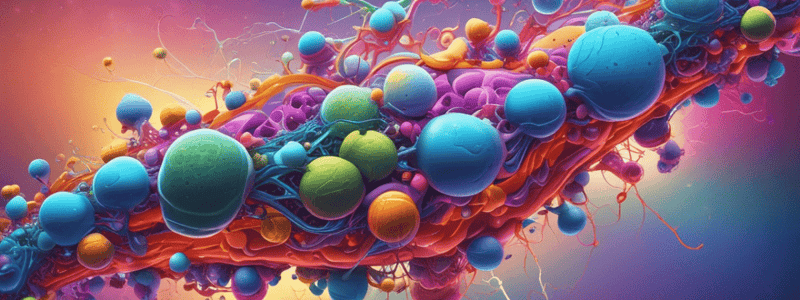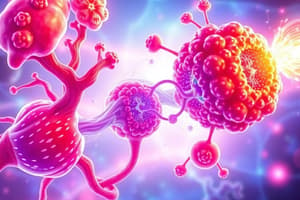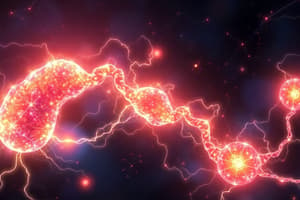Podcast
Questions and Answers
What is the main purpose of the malate-aspartate shuttle system?
What is the main purpose of the malate-aspartate shuttle system?
- To generate 2.5 ATP per pair of electrons passed from NADH to oxygen
- To transport electrons from NADH in the cytoplasm to complex I in the mitochondria
- To indirectly convey cytosolic NADH into mitochondria for oxidation (correct)
- To directly transport NADH from the cytoplasm into the mitochondrial matrix
Why is the malate-aspartate shuttle considered the most active shuttle mechanism?
Why is the malate-aspartate shuttle considered the most active shuttle mechanism?
- It can generate 2.5 ATP per pair of electrons passed from NADH to oxygen
- It can transport electrons from NADH in the cytoplasm to complex I in the mitochondria
- It depends on two transporters that allow for the exchange of malate and aspartate across the inner mitochondrial membrane (correct)
- It can directly transport NADH from the cytoplasm into the mitochondrial matrix
How does the malate-aspartate shuttle system indirectly convey cytosolic NADH into the mitochondrial matrix?
How does the malate-aspartate shuttle system indirectly convey cytosolic NADH into the mitochondrial matrix?
- By using the exchange of malate and aspartate across the inner membrane to shuttle the electrons (correct)
- By transferring electrons from NADH in the cytoplasm to complex I in the mitochondria
- By directly transporting NADH across the inner mitochondrial membrane
- By generating 2.5 ATP per pair of electrons passed from NADH to oxygen
What is the role of complex I in the malate-aspartate shuttle system?
What is the role of complex I in the malate-aspartate shuttle system?
What is the purpose of shuttling the electrons from cytosolic NADH into the mitochondrial matrix?
What is the purpose of shuttling the electrons from cytosolic NADH into the mitochondrial matrix?
What is the composition of the F1 subunit of the ATP synthase complex?
What is the composition of the F1 subunit of the ATP synthase complex?
What is the role of the two b subunits (b2) in the Fo subunit of the ATP synthase complex?
What is the role of the two b subunits (b2) in the Fo subunit of the ATP synthase complex?
What is the role of the $eta$ subunits in the ATP synthase complex?
What is the role of the $eta$ subunits in the ATP synthase complex?
What is the primary driving force for ATP synthesis in mitochondria?
What is the primary driving force for ATP synthesis in mitochondria?
Which of the following is NOT a component of the proton-motive force?
Which of the following is NOT a component of the proton-motive force?
What is the correct formula for calculating the free energy (ΔG) of the proton-motive force?
What is the correct formula for calculating the free energy (ΔG) of the proton-motive force?
In the chemiosmotic model for ATP synthesis, what is the role of the electron transport chain?
In the chemiosmotic model for ATP synthesis, what is the role of the electron transport chain?
Which of the following statements about the proton-motive force is correct?
Which of the following statements about the proton-motive force is correct?
In the formula for calculating the free energy (ΔG) of the proton-motive force, what does the term 'ZFΔψ' represent?
In the formula for calculating the free energy (ΔG) of the proton-motive force, what does the term 'ZFΔψ' represent?
What is the primary mechanism that regulates oxidative phosphorylation?
What is the primary mechanism that regulates oxidative phosphorylation?
What is the function of the F-type ATPases?
What is the function of the F-type ATPases?
What is the role of the inhibitor of F1 (IF1) protein?
What is the role of the inhibitor of F1 (IF1) protein?
What happens when oxidative phosphorylation is inhibited?
What happens when oxidative phosphorylation is inhibited?
Under what conditions is the IF1 protein active?
Under what conditions is the IF1 protein active?
What is the purpose of the coordinated regulation of ATP-producing pathways?
What is the purpose of the coordinated regulation of ATP-producing pathways?
What is the primary role of the adenine nucleotide translocase in the mitochondrial inner membrane?
What is the primary role of the adenine nucleotide translocase in the mitochondrial inner membrane?
How does the proton-motive force contribute to ATP synthesis and substrate transport in the mitochondrial matrix?
How does the proton-motive force contribute to ATP synthesis and substrate transport in the mitochondrial matrix?
What is the role of the phosphate translocase in the mitochondrial inner membrane?
What is the role of the phosphate translocase in the mitochondrial inner membrane?
What is the significance of the conformational change in the F1 beta subunits of the ATP synthase complex?
What is the significance of the conformational change in the F1 beta subunits of the ATP synthase complex?
What is the net charge movement across the mitochondrial inner membrane during the transport of ADP and Pi into the matrix?
What is the net charge movement across the mitochondrial inner membrane during the transport of ADP and Pi into the matrix?
What is the driving force for the transport of H2PO4- into the mitochondrial matrix by the phosphate translocase?
What is the driving force for the transport of H2PO4- into the mitochondrial matrix by the phosphate translocase?





